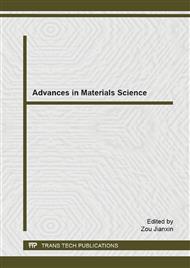p.174
p.181
p.186
p.191
p.195
p.200
p.206
p.213
p.217
XRD, STEM, and Tensile Properties of AISI S1 Tool Steel after Deep Cryogenic Treatment
Abstract:
Successful employment of advanced tool steel in engineering applications is related to its ability in terms of meeting service life requirements and fabrication with proper dimensions. Deep cryogenic treatment may be used to produce advanced tool steel by simultaneously increasing toughness, strength, and hardness. Twelve sets of specimens were tested in this paper, 9 of which were deep cryogenic treated and then tempered. Tensile properties, hardness, X-ray diffraction, and scanning transmission electron microscopy were applied for macroscopic and microscopic investigations. The best results of simultaneous improvement in toughness, hardness, and strength were obtained for 36 h soaking time and 1 h tempering time.
Info:
Periodical:
Pages:
195-199
Citation:
Online since:
February 2015
Authors:
Price:
Сopyright:
© 2015 Trans Tech Publications Ltd. All Rights Reserved
Share:
Citation:


